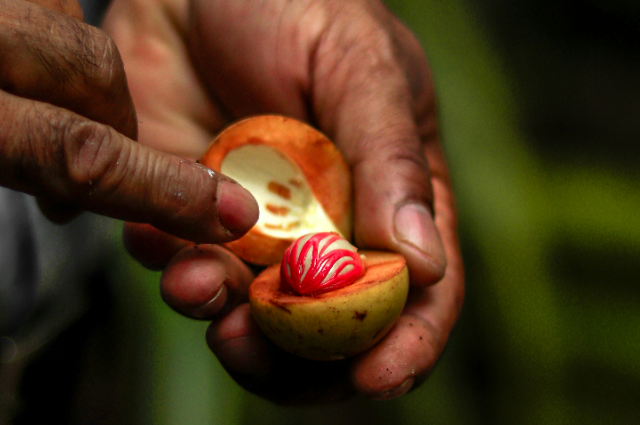
Photo by Ian Yeo on Unsplash
Nutmeg and mace are both derived from the fruit of the Myristica fragrans tree, commonly known as the nutmeg tree. This aromatic evergreen tree is native to the Moluccas, or Spice Islands, in Indonesia, and is renowned for producing two distinct and valuable spices from its fruit – nutmeg and mace. The fruit of the nutmeg tree is a yellowish-green drupe, resembling a small apricot or peach. Within this fruit is a seed known as the nutmeg, and the bright red aril that covers the seed is the source of mace.
The harvesting process begins when the fruit ripens, at which point it splits open to reveal the vibrant red mace covering the seed, nestled within the fruit. This is a crucial moment for harvesting, as both nutmeg and mace must be collected at the right stage of ripeness to ensure optimal flavour and aroma. The first step in obtaining nutmeg and mace involves removing the aril, which is carefully peeled away from the seed. This delicate process is usually done by hand, as machines might damage the valuable mace.
Once the mace is separated, the remaining nutmeg seed is exposed. The nutmeg seed is oval and approximately the size of a small plum pit. After the initial extraction, the mace and nutmeg undergo distinct processing methods. The mace is typically left to dry in the sun, where it gradually changes from its vivid red hue to a more subdued orange or pale yellow colour. This drying process intensifies the flavour and aroma of the mace, creating a spice with a complex profile featuring warm, sweet, and slightly spicy notes. Meanwhile, the nutmeg seed undergoes a two-part processing method.
Initially, the seed is left to dry, resulting in the hard, brown nutmeg kernel. Once dried, the outer shell is cracked open to reveal the seed inside. This kernel is then ground into the familiar powdered nutmeg found in spice racks around the world. Nutmeg has a warm and slightly sweet flavour, making it a versatile spice used in both sweet and savoury dishes. Despite their close connection, nutmeg and mace have distinct culinary applications due to their unique flavour profiles. Nutmeg is commonly employed in baking, desserts, and savoury dishes, contributing warmth and depth to everything from pies to creamy sauces. On the other hand, mace is often used in more delicate dishes, such as custards, sauces, and light soups.
Its flavour is considered milder and more refined compared to nutmeg, allowing it to enhance dishes without overpowering other ingredients. Beyond culinary applications, both nutmeg and mace have historical significance and medicinal uses. Throughout history, they have been valued for their perceived digestive benefits and as remedies for various ailments. Their aromatic qualities also led to their use in perfumes and as components in traditional medicines in different cultures. In conclusion, nutmeg and mace, though derived from the same fruit, offer distinctive flavours and aromatic profiles that make them essential spices in the culinary world.
The careful harvesting and processing of the nutmeg tree's fruit results in these two valuable spices, each with its own set of applications in cooking and beyond. Whether sprinkled atop a latte or incorporated into a savoury stew, nutmeg, and mace continue to play a significant role in enhancing the flavours of diverse dishes worldwide.
